|
Paid Search can be a little overwhelming when trying to get your head around it for the first time. But there is nothing to fear, the ingredients are simple and even as a novice you'll quickly understand the basics. Let me give you a first taste of what the Paid Search brew is made of. What is Search? Search is a pull medium and that is the beauty about it because you can pull in those searchers when they are in an active state of mind. You would know from your own searches on search engines like Google or Bing that you want results and relevant content. As a business you can meet those consumers right there at the right time and with the right content. In order to do that you need to be there and show up in the search results. Search is very different to other marketing channels like TV advertising or billboards. You might be on your way to work and there is a billboard on the way, but as you are driving you might or might not see it and be aware of who is advertising and what. The advertising medium in that case either interrupts what you are doing or you don't even notice the advertising is there at all because your eyes are focused on the road. With Search you have the ability to pull the person in when they are actively searching for what you might be offering. Why is Search so Important? There are over 6 billion searches on Google happening each day*! Search tends to be the first thing people do when they start research, be it for a product, services, knowing what the weather will be like, opening hours and so on. Google is leading the world, owning over 73% of the desktop search market and 91% of the mobile search market globally**. Microsoft's Bing comes second before Baidu (the major Chinese search engine). For Australia the market shares are similar with Google dominating the space all the way, but Bing being a valid second option when running Paid Search due to the different nature of their audience and being slightly less competitive for advertisers. What is the Difference between SEM and SEO? 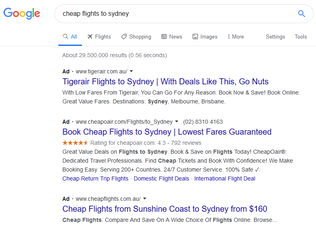 Paid Search Ads Paid Search Ads Let's look at a few definitions here and get you familiar with the different words and acronyms that are commonly used in Search. Paid Search or Pay per Click (PPC) ads and results are the ones showing on top of the search results (and sometimes at the bottom of the search engine results page - SERP). Paid Search ads are usually labeled as such. Google has been experimenting with the look and feel of the SERP, so things could look different for you depending on where you are, what browser you use and what you are searching for. 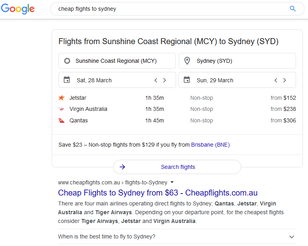 Organic Search Results Organic Search Results Organic Search or Natural Search results fill up the rest of the page. They appear underneath the paid search results when you scroll further down the page and can look similar to paid ads or very different like the flight comparison table here. The optimization for organic search results is called Search Engine Optimization or SEO. SEO is active work on the website to make it more discoverable for search engines like Google and your website relevant for your users and searchers. Technical SEO focuses on making sure your website loads fast, is mobile-friendly (or better mobile-first), indexed well and so on. Having the relevant content is key to ranking well in the search engine results when someone searches for a keyword that is relevant to what you offer. Search Engine Marketing (SEM) or Search Engine Advertising (SEA) or PPC (Pay Per Click) Advertising means that an advertiser pays to show in the search results. They only pay when someone clicks on their ad (this is different to display or banner advertising and also social advertising where they pay every time their ad is shown, no matter if the person actually sees or interacts with the ad). It is an auction process (think ebay). Not necessarily the highest bidder will show in position one, but the one who has the most relevant ad (it is rather a complex system these days that guarantees relevancy for the user - and revenue for Google). We'll get into this more later. Why Pay When You Can Get Listed For Free? There are several benefits of paying to be listed: 1. Paying gives you full control over what the search result says. For example if you are running a sale for a limited time, your SEO is unlikely to pick this sale up in time as Google does not scan for updates every minute or day. SEO is a mid to long term strategy whereas paid search can be a short term strategy (it should always be on though, don't run it as an on and off campaign as it will harm your ad rank. This will become clearer when we talk about relevancy later). 2. If you have a new website or service it takes some time until you rank in the organic listings. Paid Search is a great way of getting your brand out there in the meantime. You can go live within a single day. 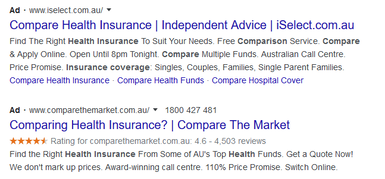 Ad extensions and more Ad extensions and more 3. Paid Search gives you a lot of extra benefits that make your listing stand out like sitelinks, different extensions like offer (a special limited time offer), location (show your physical shop locations) or phone (show your phone number so customers can call you directly) extensions, structured snippets (to showcase some of your offers) and much more. The more you use these extensions and extras the more space you will take up in the search results and the more likely someone will click on it. 4. You can make sure your brand message is there and no competitors are showing up when someone searches for your brand. Google has much stricter trademarking regulations these days, but it still happens that irrelevant results show up from time to time. Don't forget if you are not there, no one will be able to find you no matter how relevant your product or services are. Relevancy is Key 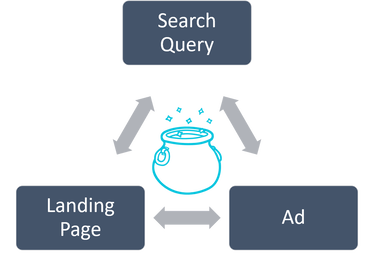 Search is all about relevancy. It is a relevancy triangle between:
It is all about giving the user, your potential new customer, the best possible experience. Just think about yourself. Let's assume you are looking to buy red sneakers that have been ethically produced, but what you get is an ad that talks about blue stilettos. I am sure you'd be put off pretty quickly and wouldn't click on that specific ad in the first place. Let's take this further and assume that the ad actually talks about red ethical sneakers, you click on it, but you land on a page that shows shoes in general and doesn't have any content about ethical manufacturing on it. You'd leave the site straight away. So if you put yourself in the shoes of your potential customer you want to make sure that what you offer is aligned with what they look for and that the experience they have on your site is great. Google will penalize you too if the search query (your keyword) isn't aligned with what you say in the ad (i.e. no mention of the keyword) or something isn't right with your ad and only few people click through to your site (low click-through-rate or CTR). Or they click, but then leave your site straight away because what you show there doesn't have anything to do with what you say in your ad (plus your landing page might load slowly, look outdated, is not clear about prices etc.). Penalizing means that Google will make you pay more to appear in the same position, drop you to a lower position (meaning you're not as visible anymore) or not show your ad at all. The system behind all this is rather complex and Google is careful not to reveal too much about their algorithm. But what we know is this: It all comes down to your Ad Rank which is a combination of your bid, the quality of your ads (= Quality Score aka relevancy) and how well Google thinks your ad will perform. Let's break it down:
Where Can I Run Paid Search Ads? In Australia, Google Ads dominate the Paid Search market with over 90% market share. Microsoft Ads run on Bing and the audience tends to be slightly more educated and higher income earners. Depending on the industry you are in, Microsoft Ads can have up to 15% market share (they have always been strong in travel for example). If you are running search for the first time I recommend to start with Google Ads first and once you have settled in and found your bearings, get your campaigns onto Microsoft Ads, too, for optimum coverage. I hope this introduction to Paid Search has shown you all the ingredients that make up the Paid Search brew and has removed your fear of giving Paid Search a go. Stay tuned for more blog posts about how you can achieve the necessary relevancy, i.e. creative, some of the more technical requirements (like character limits) and best practice that will help you in your PPC day in and day out. Are You Still Overwhelmed by Paid Search or has my Post Removed some of those Fears? |

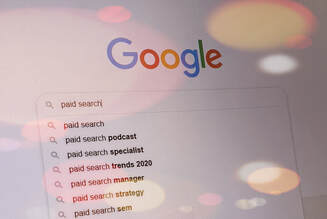
 RSS Feed
RSS Feed